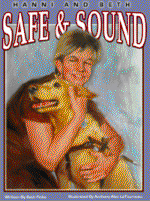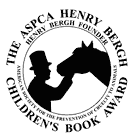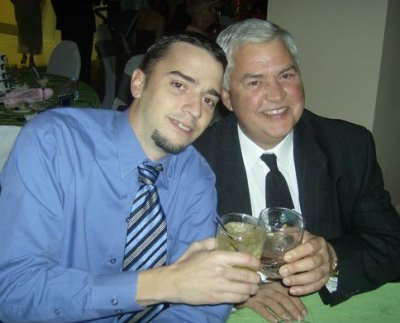Helper Parrots & Guide Horses: Where to Draw the Line?
January 3, 2009 • 29 Comments • Posted in guide dogs, radio, Seeing Eye dogs, UncategorizedYesterday’s Day to Day programon National Public Radio (NPR) aired a story called Helper Parrots, Guide Horses Face Legal Challenges.
Day to Day, January 2, 2009 • Chances are you’ve seen a blind person accompanied by a guide dog. But what about a guide horse, a service parrot or a monkey trained to help an agoraphobic?
These are just a few of the nontraditional service animals that are used across the country to help people with disabilities and psychological disorders.
As their uses are expanding, however, the government is considering a proposal that would limit the definition of “service animal” to “a dog or other common domestic animal.”
Day to Day host Alex Cohen interviewed Rebecca Skloot, the author of an article in the New York Times Magazine called Creature Comforts – Assistance Animals Now Come in All Shapes and Sizes.
Rebecca Skloot outlines why many people are upset about the pending law. Sometimes less familiar animals make better helpers, she tells Alex Cohen.The NPR story described how Sadie, a parrot, helps a man who suffers from bipolar disorder. The parrot can sense when he is on the verge of a psychotic episode and talk him down. Richard, a bonnet macaque monkey, helps a woman get through the day without debilitating panic attacks. And Panda, a miniature guide horse, guides a woman who is blind.
Skloot spent many hours observing how a miniature horse named Panda helped a blind woman named Ann Edie. Even after all her preparatory research, Skloot was blown away.
“I could sort of envision how a horse could guide a person. But the level at which Panda guides her is amazing. In just a few blocks, I saw her maneuver around things that I, as a person that’s sighted, wouldn’t have thought of.”
When it comes to getting into airports, restaurants and other public places with a service animal, the ADA allows employees to ask a person if the animal is a service animal, and if the animal is required because of a disability. Documentation of the person’s disability or the animal’s training can NOT be required as a condition for providing service to an individual accompanied by a service animal.
In other words, people don’t have to prove they are disabled or that their pets are service animals in order to have those animals accompany them into a public place. All a person has to do is claim a disability and say their pet has been trained to provide assistance. No questions asked.
This is just one of many reasons the government is considering revising the definition of “service animal” in the American’s with Disabilities Act – it’s not simply because bigoted dog lovers want to keep other animals off the list.
A piece I wrote for The Bark about a teenager who sat next to me on a plane helps explain:
“I’m an only child. Rusty’s like a brother to me.”
Unwilling to have their German Shepherd fly as cargo on family vacations, her dad came up with a solution. “My dad wears sunglasses,” she said with a laugh. “He acts like he’s blind, and pretends our German Shepherd is a Seeing Eye dog. He even, like, had somebody at the leather shop make one of those harness things for Rusty.” She was really laughing now. Can you believe that?”
I could. In fact, this was the second time I’d been given a firsthand account of someone faking blindness to get a dog into an airport. I’ve heard stories, too, about people faking or exaggerating other maladies in order to get their animals on board with them.
“We are getting more and more complaints about service dogs,” a specialist on the Americans with Disabilities Act (ADA) information line told me. She said that most complaints come from business owners. People with guard dogs, attack dogs, therapy dogs, companion dogs, and even security dogs are calling their dogs “service” animals to get them special privileges. “We just tell businesses to let the dogs in,” she said. “Otherwise they’re asking for a lawsuit.”
I guess “reasonable accommodation” is just a one-way street, then? Doesn’t seem fair to me.
Those of us with legitimate service animals suffer when others fake or exaggerate a disability so they can bring their pets wherever they go. Last year I was stopped while trying to get into a Cubs game at Wrigley Field with Hanni. The man taking tickets said he didn’t know if the dog was allowed. I pointed to Hanni’s harness, told him she was a Seeing Eye dog. He was skeptical.
Turns out that a week earlier someone had brought their puppy to Wrigley, claiming the dog was a service dog. The dog misbehaved, and fans sitting nearby complained. After that, the people working the gates were told to scrutinize anyone coming in with a service dog.
In addition to being despicable, faking a disability to gain privilege is fraud. It also results in increased scrutiny of people with legitimate disabilities. I’ve had this happen at Crate and Barrel on Michigan Avenue. And at Andy’s Jazz Club on Hubbard. At Jimmy John’s Sandwich Shop on State Street.
I was stopped at the door at each place. At the first two, the doorman checked with a supervisor before letting me through. At Jimmy John’s, they just kicked Hanni and me out. We haven’t been back.
The Seeing Eye is celebrating its 80th anniversary this year. As the very first school in the US to train guide dogs for the blind, Seeing Eye pioneers worked long and hard to open the doors and give our dogs public access. I can tell you stories and stories of people who have faked blindness or other disabilities to get their pet dogs into public places. I have no problem allowing qualified service animals of any type – horses, monkeys, parrots — into public places with their disabled human companions. I just worry that opening ADA legislation to even more animals who may not truly be qualified could possibly ruin the good name our Seeing Eye pioneers have worked so hard to build over the years.
You can read more about the proposed legislation in Skloot’s article in The New York Times Magazine and see photos of her blog.



